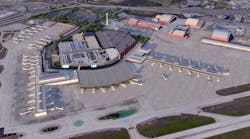... there’s been significant progress among the airport community in reporting wildlife ‘strikes’ with aircraft. At least that’s the word from Michael J. Begier, the national coordinator for the U.S. Department of Agriculture’s Airport Wildlife Hazards Program. One area that in particular needs improvement in reporting: general aviation airports.
The USDA's Begier relates that in the 1990s the FAA asked USDA to maintain its database of wildlife strikes. “FAA is not a traditional natural resources agency,†he explains. The database became the subject of a media brouhaha following the Hudson River incident; while the media spotlight has faded, the need for better reporting became more prominent. It remains voluntary, says Begier. “There had been a gentleman’s agreement to not share the information for fear it could reflect poorly on industry. I can’t speak for FAA, but the feeling was maybe this database should have some protection. It became a real big story. So DOT decided it should be open to the public.â€
In fact, says Begier, reporting has improved significantly since the Hudson incident. “A reason we want more reporting is, you can’t fix it if you haven’t managed it,†he says. “A biologist can make more informed guidance if he or she knows precisely what type of wildlife is a threat at an airport. There may be something that is encouraging it.â€
Begier says that a study completed within the past year suggests that some 40 percent of actual strikes are being reported at Part 139 airports – a statistic that is high enough to allow for FAA policymaking to be considered legitimate. It had been assumed that perhaps only some 20 percent of strikes were being recorded.
“The quality of the data is good. So, FAA feels it doesn’t need to be mandatory. We’re getting good data with a voluntary system,†says Begier.
That said, Begier estimates that only some six to seven percent of the strike reporting comes from GA facilities. It’s a concern, he says, particularly because GA airports often don’t have the necessary infrastructure like fencing to deter strikes. For those facilities, understanding the area’s wildlife and foliage (the “attractantsâ€) via the input of a FAA-certified wildlife biologist can have a significant impact on a wildlife management program.
Thanks for reading. jfi
(Look for more on USDA’s wildlife management program in the upcoming September issue of AIRPORT BUSINESS magazine.)



